Author: CryptoVizArt, UkuriaOC, Glassnode; Compiler: Tao Zhu, Golden Finance
Abstract:
Although prices have been volatile and trading sideways since March, both Ethereum and Bitcoin markets have shown relative strength after enduring a prolonged period of post-ATH consolidation.
The U.S. Securities and Exchange Commission’s (SEC) approval of an Ethereum spot ETF surprised the market, causing ETH prices to rise by more than 20%.
Net flows to the Bitcoin US Spot ETF turned positive again after four weeks of net outflows, indicating a pickup in TradFi demand.
Spending pressure on long-term holders has cooled significantly, with investors returning to accumulation mode, suggesting volatility is needed to drive the next wave.
Market Resilience Increases
Bitcoin has recovered to ATH after recording its deepest closing correction since FTX lows (-20.3%) , reaching $71,000 on May 20. From a comparative perspective,the retracement pattern of the 2023-2024 uptrend appears to be very similar to the 2015-2017 bull market.
The 2015-2017 uptrend occurred during Bitcoin’s infancy, when there were no derivatives available for the asset class. A comparison we can make with the current market structure suggeststhat the uptrend in 2023-2024 may be primarily a spot-driven market. The launch of U.S. spot ETFs and inflows support this view.
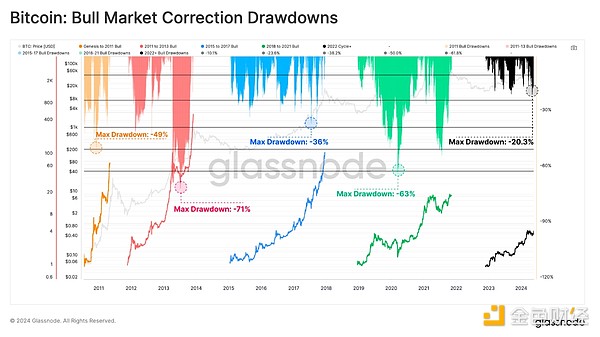
Since FTX lows Since then, Ethereum’s correction has also been significantly shallower compared to previous cycles. This structure suggests that the market is becoming somewhat more resilient and that downside volatility is decreasing between each successive pullback.
However, it is worth emphasizing that relative to Bitcoin, Ethereum recovery is slower. ETH has also significantly underperformed compared to other leading crypto assets over the past two years, reflected in the weaker ETH/BTC ratio.
Nevertheless, this week’s U.S.spot Ethereum ETF approval is a The generally unexpected development could provide the necessary catalyst for a stronger ETH/BTC ratio.
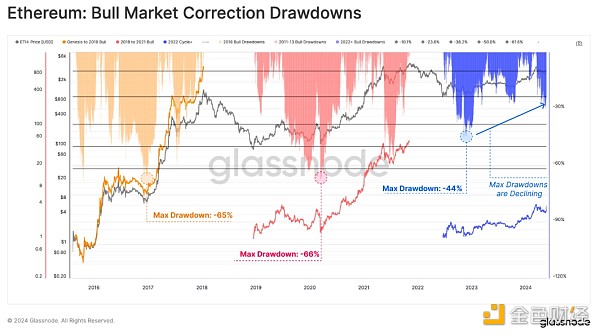
If we examine the rolling performance of the Bitcoin market on the weekly (red), monthly (blue) and quarterly (orange) timeframes, we can see that the overall performance was strong, recording +3.3%, +7.4% and +25.6%.
To highlight periods of particularly strong price performance, we can count the number of trading days in which all three timeframes performed above +20% within a 90-day window. Only five days so far last quarter have reached that threshold.
In previous cycles, this number reached 18 to 26 days, indicating that the current market is relatively Historical bull markets may be more cautious.
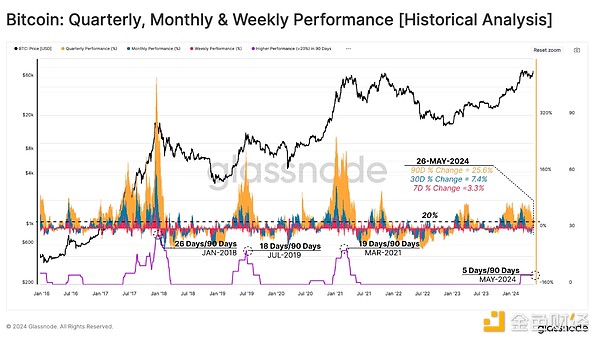
We can use similar Ethereum is evaluated within the framework and can see the huge impact of ETF approval. The news sparked almost immediate buyer pressure, with price movements exceeding 20% for the first time since late 2021.
If we consider the outsized impact spot ETFs have had on Bitcoin since the start of the year, the ETH/BTC trading pair may be showing early signs of a brighter future.
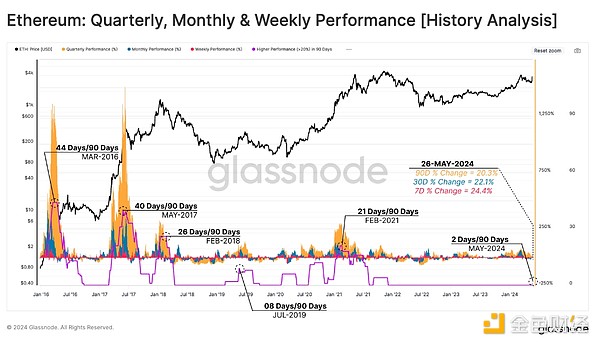
ETF buyers are making a comeback
In early March, the price of Bitcoin decisively broke through a new high of $73,000, while long-term holders were selling off a large amount of supply. This seller created a supply glut that led to a period of correction and consolidation. Over time, lower prices and seller fatigue begin to give way to a reaccumulation mechanism.
We can see this in Bitcoin ETF flows, which shifted to net outflows throughout April. As the market sold off to local lows around $57,500, the ETF saw massive net outflows of -$148 million per day. However, this proved to be a micro-capitulation and the trend has since reversed sharply.
Last week, the ETF experienced significant net inflows of $242 million per day, signaling a return to buyer demand. Given the natural daily selling pressure from miners since the $32M/day halving, the ETF has seen almost 8x the buying pressure. This highlights the size and scale of the ETF's impact, but also highlights the relatively small impact of the halving.
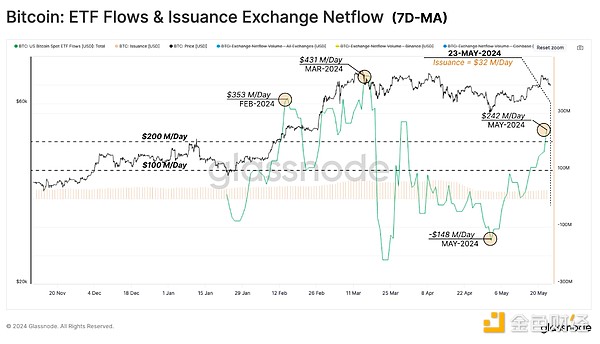
Back to excitement
Circulating supply as a percentage of profits provides valuable information about each market cycle, and a set of repeating patterns emerge. In the early stages of a bull market, when price was trying to recoup previous ATH, the supply percentage from profits crossed a statistical threshold of about 90%. This marks the beginning of the pre-euphoria phase, which historically has attracted investors to take profits from the gambling table.
This seller pressure is often attributed to long-term holders who take the opportunity to exit the market at a high price, especially after enduring the downside volatility throughout a bear market.
As the market breaks new ATH and price discovery, it enters the excitement phase where profit supply starts to fluctuate around the 90% level over the next 6-12 months. The current phase of excitement is relatively new, but has been active for about 2.5 months, and as of this writing, 93.4% of the supply is in profit state.
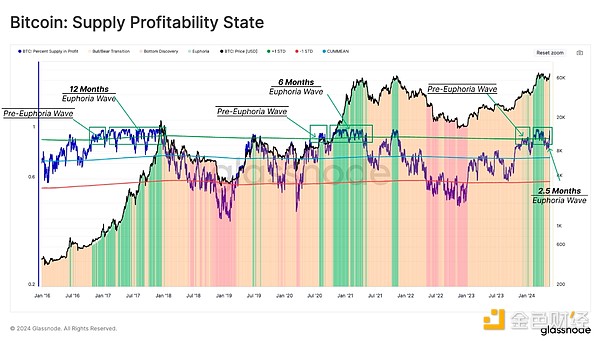
Another tool we can use to monitor corrections is the size of unrealized losses held by investors. Given that unrealized losses around ATH represent "top local buyers," we can assess the proportion of supply falling within the 90-day rolling window of losses. The aim is to estimate the percentage of coins that have lost their “profitable” status compared to their local price peak.
Mechanistically, these deep declines occur when new capital enters the network, absorbing the sell-side pressure distributed during local uptrends, and then falls into losses on the ensuing correction.
The depth of retracement in the current uptrend is also similar to the 2015-2017 bull market, again indicating that the market is relatively Strong. This suggests that despite the local spikes, too many tokens did not appear to be purchased at exorbitant prices.
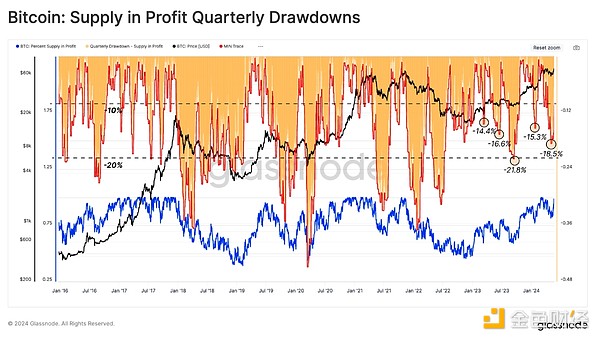
Buyer Pressure vs. Seller Pressure
As prices rise due to new buyer pressure, the importance of counterparties from long-term holders (i.e. seller pressure) also grows. Therefore, we can measure the LTH group's motivation to sell by assessing their unrealized profits, and actual sellers by their realized profits.
First, LTH's MVRV ratio reflects its average unrealized profits multiple. Historically, the transition phase between bear and bull markets is when LTH trades above 1.5, but below 3.5 (red), and can last between one and two years.
If the market's upward trend continues and new ATH is formed in the process, the future holdings of LTH Realized profits will expand. This will greatly increase their motivation to sell and ultimately lead to a level of seller pressure that gradually exhausts the demand side.
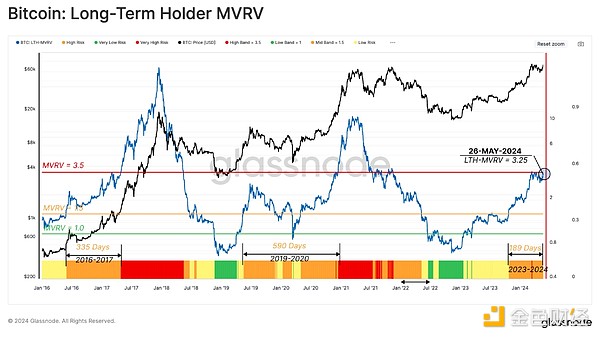
To conclude this evaluation, we will evaluate LTH's payout rate through the 30-day net position change in LTH supply. In the run-up to ATH in March, the market experienced the first major LTH allocations.
In the past two bull markets, LTH’s net allocation rate reached 836,000 to 971,000 BTC/month. Currently, net selling pressure peaked in late March at 519,000 BTC/month, with approximately 20% coming from Grayscale ETF holders.
This high spending state is followed by a cooling-off period, and a state of partial accumulation results in total LTH supply growing by approximately +12,000 BTC per month.
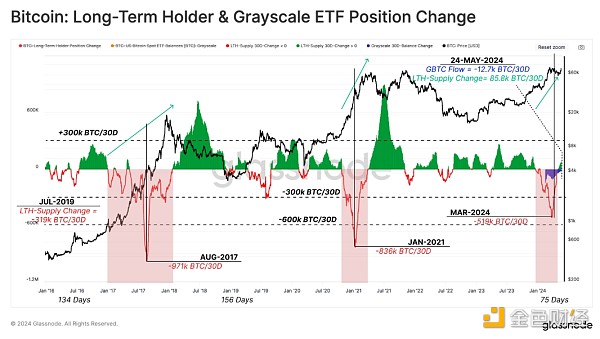
Summary
After long-term investors invested a large amount of $73,000 ATH, the pressure on the sellers decreased significantly. Long-term holders have since started accumulating Bitcoin again for the first time since December 2023. In addition to this, demand for spot Bitcoin ETFs has also picked up significantly, with positive inflows reflecting significant buyer pressure.
Additionally, the playing field between Bitcoin and Ethereum has been leveled with the SEC’s approval of a U.S. Ethereum spot ETF. This further solidifies the growing adoption of digital assets across the traditional financial system and is an important step forward for the industry.
 JinseFinance
JinseFinance









